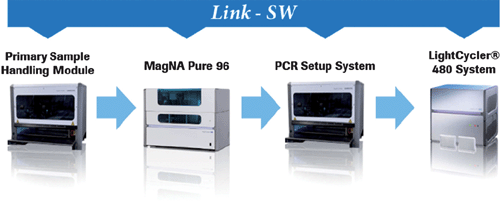Trends in instrumentation in diagnostic molecular microbiology
Sepehr N TabriziDepartment of Microbiology
The Royal Children’s Hospital
Parkville, Vic. 3052, Australia
Email:
Sepehr.Tabrizi@thewomens.org.au
Microbiology Australia 34(4) 182-183 https://doi.org/10.1071/MA13061
Published: 26 September 2013
In recent years, replacement of conventional microbiological culture-based diagnostic testing with molecular detection of bacterial, fungal and viral pathogens has become routine across many laboratories. This increase in adopting molecular methods has been primarily due to the availability of automated instrumentation that can provide results in a timely and efficient manner, without the need for in-depth knowledge of molecular biology. The use of molecular methods is therefore translating into better treatment, care and management of patients. Advancement in instrumentation has occurred across all stages of molecular testing from pre- to post-analytical stages of testing. This short summary is by no means exhaustive of all systems available or soon to become available; however, it gives a brief overview of the most common instruments in use and also some of the advancements that are in the process of becoming available.
An increasing number of molecular instruments are available for use in laboratories. The utility ranges from pre-analytic sample handling and pipetting to nucleic acid extraction, amplification and post-analytic processing (Table 1). Included among these are a number of platforms that have integrated primary sample processing, testing and reporting using a bidirectional laboratory information management system (LIMS) connection. This allows diagnostic results to be reported faster and with more accuracy. Most of the integrated systems are closed platforms that only allow use with specific assays manufactured by their respective manufacturers. An exciting advancement is integration of pre-analytic pipetting and hit (cherry)-picking platforms including Tecan Freedom Evo, which allows LIMS enquiry with automated picking from a range of samples on board for appropriate tests of choice. However, such open systems require some optimisation and adaptation to the users’ applications and integration with other platforms used in the laboratory. An upcoming advancement in instrument integration by Roche, called Roche FLOW, combines a few of the existing Roche platforms to allow a truly open platform for pre-analytic, analytic and post-analytic integration (Figure 1). FLOW allows flexible primary tube loading using a new primary sample handling platform, nucleic acid extraction using MagNA Pure 96, a new PCR set-up platform and amplification on LightCycler® 480. The process uses reagent and specimen tracking through a common software with ability to link to LIMS. This system allows high-throughput testing with the ability to process >384 samples and generate over 1000 qPCR results per 8-hour workday. Such an open system platform allows laboratories to enhance their automation, minimising the risk of transcription error and improving result reliability. It also allows economic use of reagents and disposables with variable batch sizes.

|

|
Advancement in the field of nucleic acid sequencing and large scale analysis will continue at a fast rate with continual improvement in bioinformatics as well as automation. Increased speed and accuracy will make the prospects of personalised medicine in the area of infectious diseases detection together with determination of virulence factors and antimicrobial resistance a reality in the near future. Mass spectrometry can provide rapid identification of multiple organisms, although cost of such instruments are prohibitive in implementation in most laboratories. However, with increase use, cost of instrumentation will naturally be lowered.
Acquiring a molecular testing system can eliminate a significant volume of costly send-out tests. Simplification of molecular assays and instruments will be critical to foster significant movement into laboratories with medium and small testing volumes and limited laboratory space. The advancement in automation and improvement of instrumentation will simplify integration of molecular assays and foster wider implementation of more efficient systems. The future is very exciting for faster, more accurate and sensitive detection of analytes using advancement in molecular detection technologies.
Biography
Sepehr Tabrizi is a molecular microbiologist with considerable expertise in the development and validation of molecular diagnostic methods for detection of bacterial, viral and fungal pathogens. He is currently the senior scientist in charge of the Molecular Microbiology Laboratory at the Royal Women’s Hospital and an Associate Professor at the University of Melbourne, Department of Obstetrics and Gynaecology. His research has had a strong focus on using molecular tools for better understanding disease transmission and clinical translation of research findings, which has led to improvements in the diagnosis, management and prevention of infections.


